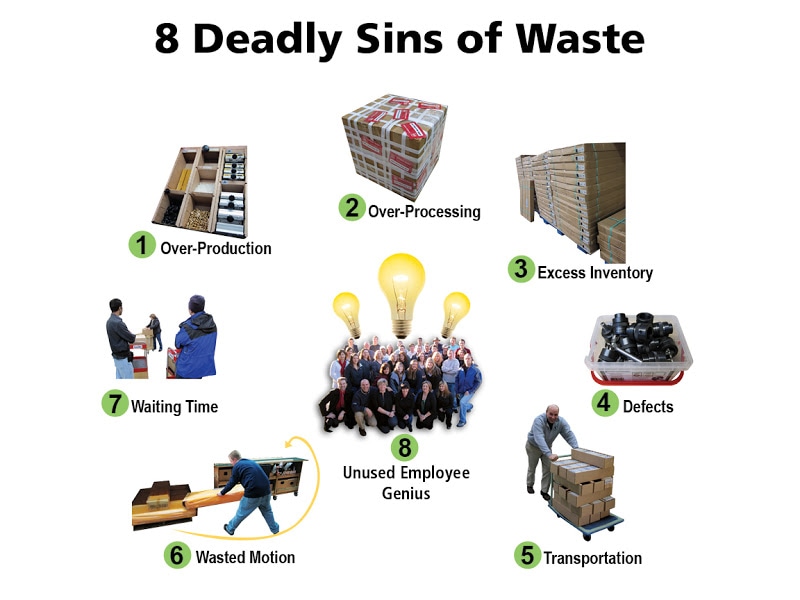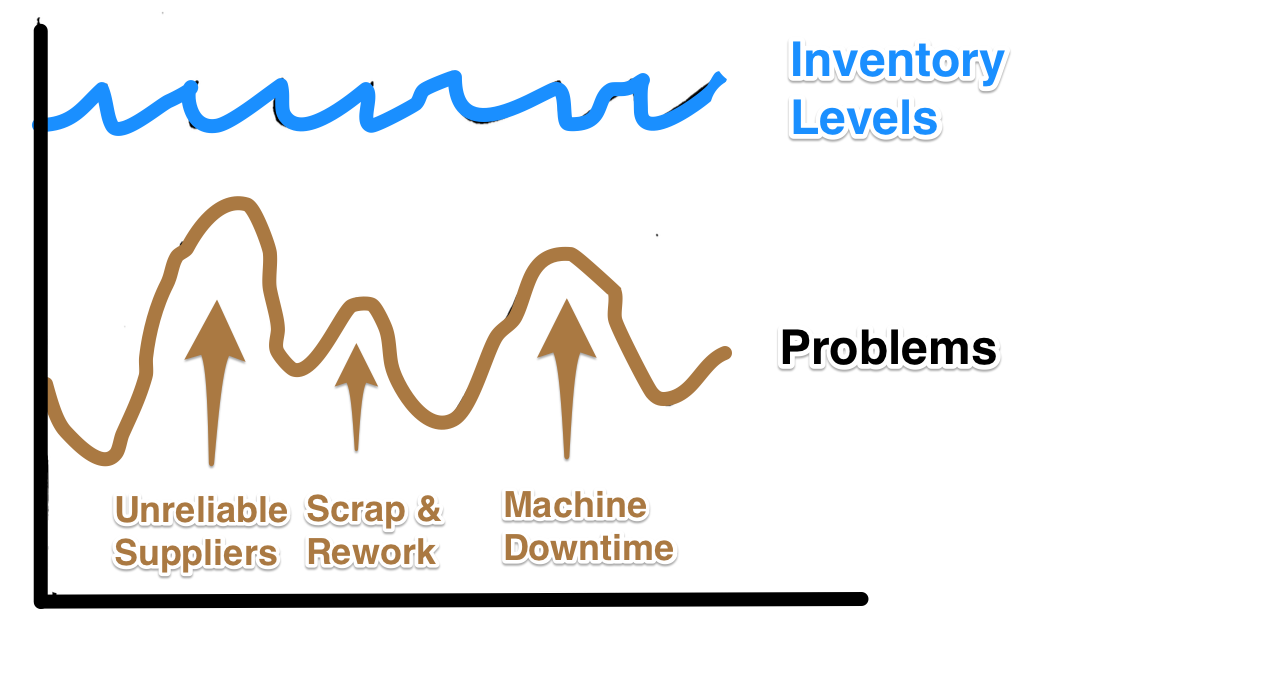2 Second Lean
Implementing Lean – First Steps, Learning to see waste
The big question that we faced when starting lean was where the hell to start? I personally tend to complicate things. A lot of people insist you start with kaizen events, implement a pull system, and creating a Value Stream Map for your processes. That sounds ultra fancy and good, but for us it wasn’t the right place to start. We believe that simplicity should be at the core of your lean implementation. Paul Akers, the founder of FastCap, turned me onto this idea with his excellent talk Lean is Simple.
Lean is about teaching and training you and your people to see waste. 99% of what we do at FLA is waste, but we couldn’t see it for what it was. We needed to learn what the 8 wastes are. Once we could identify and see waste, we devised ways to eliminate it. Like playing an instrument or riding a bike, we must train ourselves and practice to see waste.
I started out with the standard definition of waste: items that you throw away like spoiled food. That’s not waste in the lean sense. Instead, ask yourself: What exactly about your process is your customer (or you) going to pay for? Think about what goes on in your organization every day. Would you pay for someone to hunt down a missing wrench for 10 minutes? Would you pay for someone to clear enough junk off of a workbench so they can assemble the product you are buying? If not, that’s waste. Waste can be an activity, a product or component, or an improperly used resource.
The customer isn’t going to pay for the part you had to redo because the paint was scratched during handling. They aren’t going to pay for your underestimation of their new kitchen remodeling job. They aren’t going to pay for the extra packaging you put with the burrito (Thanks to Paul Akers for shooting this video). They aren’t going to pay for missing screws or defective parts.
Everything mentioned above is a waste that can be eliminated. There are eight types of waste and the first step is to learn to identify each different type. Let’s go through them.

Image By FastCap
1. Over-Production
When we produce or buy (the parts are produced for us) more than we need at the time to fill orders. Over-Production is the most expensive type of waste because it directly leads to more waste. The goods you over produced are incurring excess cost the entire time they are sitting. It cost you money to produce, more to store, and more to manage. Then, suppose a change needs to be made to the part. All the parts are bad and have to be scrapped, which made everything you’ve ever done with them including the original production waste. Examples include:
- We make extra injection molded parts for a customer because it takes 2 hours to switch the mold. We think we can pull from inventory in the future as a customer want it and save ourselves 2 hours switching out the mold.
- A church orders 100 extra bulletins just in case more people show up (Hint: After the service they become scrap).
- A company orders 5,000 fasteners instead of the 1,000 they need for the month because the unit price is $0.03 less.
- A concession stand makes extra hot dogs and hamburgers (What do you think happens to the extra’s after the game?)
In each example, we need to move it to storage (excess transportation), store it (excess inventory), and manage it (wasted motion). In some cases, we scrap product and all that value you originally put into production is wasted. Over-Production is ultimately eliminated by making exactly what the customer/next process requires, at exactly the right time, in exactly the right quantity.
2. Over-Processing
Over-Processing happens when you do things the customer doesn’t want and wouldn’t pay for. In the big picture above, you saw the box wrapped in much more tape than it needed to be. As a customer, would you pay for either the tape or the time it took to apply it? I sure wouldn’t. The burrito video mentioned above is a perfect example of over-processing, as are these examples:
- Sending a product manual in color when black and white (or providing the manual online) would have been just as good.
- A Starbucks barista putting lids on the coffee when the majority of customers immediately remove them to add creamer.
- Applying a chrome finish to a cowling that is buried inside the engine compartment and never seen.
- Mailing a customer a reciept for an online order that they already got an email confirmation for.
If a customer is unwilling to pay for additional processing steps and doesn’t find them to be valuable, those steps need to be skipped. When we are customer service minded, we tend to go above and beyond in the name of customer service. What if the value the customer recieved from going above and beyond is minimal compared to the cost?
3. Excess-Inventory
Excess inventory is always the result of over-production (both making yourself or ordering from a vendor). But why is having excess inventory bad? Many people believe in building inventory because they’ll never run short of product and can be flexible to a customers needs. But, inventory poses some costs:
- Inventory takes up valuable floor space.
- It requires heating and cooloing and protection from the elements.
- It requires a system and people to catalog it, track it, and inspect it.
- Sometimes inventory goes bad or obsolete and then all the effort put into it is totally wasted.
- If you don’t have room to store inventory, it might end up in the aisles and potentialy come a safety hazard if people can’t move around it or it blocks their path.
Most often, we have a bunch of inventory to cover up other problems with our processes. When inventory levels get to low, it exposes problems that the company runs into. Think of problems like rocks under the water and inventory like that water level. If inventory (water level) is low enough we expose the problems with our processes and could run our company (ship) into the rocks. More inventory (higher water level) is the quick fix to get rid of the problems. The lean way of thinking is to gradually lower the inventory and remove the rocks till the surface is flat.

4. Defects
You create products that have defects in them or are not what the customer requested. Examples include:
- Drilling holes in the wrong location.
- Serving a customer a regular soda instead of a diet soda.
- A product with missing parts, which the customer then has to identify and request replacements for.
- Putting Pickles and Onions on a burger when the customer didn’t want them.
In each case, material and effort are wasted on things that won’t be used. Worse case, the defect reaches customer and they are now frustrated. Best case, you catch it early in the process and it’s correctable with minimum overhead. We should always strive to make each product correctly the first time and build in processes to catch errors quickly before they snowball into bigger, more expensive problems.
5. Transportation
Any time you move raw materials or finished product, you generate waste. This is due to the transportation adding no value to the product. Most of the time, we think of transportation as shipping goods to a location, but it can be internal as well.
- A factory stores raw materials in a warehouse or across the factory that must be transported to the assembly lines.
- A restaurant has to transfer meat from the freezer down in the basement to the cooking area.
- A contractor parks his truck in the front of a house and has to transport materials and equipment to the backside of the house to build a deck.
We still buy some things from overseas vendors. The extra lead time involved in getting it and the cost of transportation are very taxing on the supply chain. Just right now we are out of a specific coupler due to unexpected demand and have been waiting over 3 weeks for new inventory. The transportation component of overseas is causing customers to wait for components.
6. Wasted Motion
Like transportation, but within your immediate area. Consider making a dish in the kitchen:
- You have to pull cooking tools and dishes out of cabinets. Lord help you if you have to find something.
- You move back and forth between the sink, the refrigerator, the stove, the trash can, and the table.
- Dirty dishes need to be put into the sink, then washed and put away.
It only takes 4 seconds to walk over to the trash can and back, but it can add up. If you do that one process 15 times, that’s 1 minute of wasted motion just walking to the trash can. What if all your utensils, ingredients, dishes and the trash can were within easy reach ready to go? To really visualize how the waste would be removed from the process, consider how easy it is to make a sub at Subway; There is very little movement, the ingredients are all right there and the process goes very quickly even if you get all the toppings. Would you be able to make a sub with all the veggies at home in the same amount of time? What’s holding you back at home is probably most likely wasted motion.
7. Waiting Time
Waiting is perhaps the most visible waste to anyone because they can clearly see that their time was wasted because of it. It is the most visible waste both inside and outside the company.
- People are consistently late for meetings, forcing everyone else to wait for 5-10 minutes before starting.
- Customers have to wait in line to be served.
- A customer has to wait 2-3 days for their order to ship.
- The guy running the drill press is waiting for the guy running the injection molding machine to get him the next batch of parts.
- A customer can’t find the information they need about a product on your website so they need to email you and wait for a response.
Everyone can relate to waiting and in general, it drives everyone crazy. Making the customer wait is always worse than making an internal person wait. We should strive to eliminate both.
8. Unused Employee Genius
The employees running each of your processes are probably the most knowledgeable about the details of those processes. They probably have things that bug them about the processes and have opinions on how they can do their job better. If those ideas could eliminate waste and make the job easier to do, why wouldn’t you want to listen?
Yet, so many companies don’t empower their employees to make the processes they perform better. Often times, an employee will suggest sometime only to have it fall on deaf ears. That employee is then discouraged from providing additional input and it tears people down instead of building them up. As a leader, you need to recognize that everyone has good ideas and the best progress comes when you encourage and inspire people to fix their work environment and make their job more enjoyable and easier.
This article is just a primer on the 8 wastes. For future blog posts, we are going to dig deeper into each of the 8 wastes individually. When you go back to work, see if you can identify each of the wastes in your workplace. Then ask yourself “why does this occur?”. Then ask yourself, “what can I do to fix it?”
